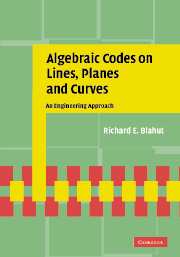Book contents
- Frontmatter
- Contents
- List of figures
- List of tables
- Preface
- Dedication
- 1 Sequences and the One-Dimensional Fourier Transform
- 2 The Fourier Transform and Cyclic Codes
- 3 The Many Decoding Algorithms for Reed–Solomon Codes
- 4 Within or Beyond the Packing Radius
- 5 Arrays and the Two-Dimensional Fourier Transform
- 6 The Fourier Transform and Bicyclic Codes
- 7 Arrays and the Algebra of Bivariate Polynomials
- 8 Computation of Minimal Bases
- 9 Curves, Surfaces, and Vector Spaces
- 10 Codes on Curves and Surfaces
- 11 Other Representations of Codes on Curves
- 12 The Many Decoding Algorithms for Codes on Curves
- Bibliography
- Index
5 - Arrays and the Two-Dimensional Fourier Transform
Published online by Cambridge University Press: 05 October 2009
- Frontmatter
- Contents
- List of figures
- List of tables
- Preface
- Dedication
- 1 Sequences and the One-Dimensional Fourier Transform
- 2 The Fourier Transform and Cyclic Codes
- 3 The Many Decoding Algorithms for Reed–Solomon Codes
- 4 Within or Beyond the Packing Radius
- 5 Arrays and the Two-Dimensional Fourier Transform
- 6 The Fourier Transform and Bicyclic Codes
- 7 Arrays and the Algebra of Bivariate Polynomials
- 8 Computation of Minimal Bases
- 9 Curves, Surfaces, and Vector Spaces
- 10 Codes on Curves and Surfaces
- 11 Other Representations of Codes on Curves
- 12 The Many Decoding Algorithms for Codes on Curves
- Bibliography
- Index
Summary
An arrayυ = [υi′i″] is a doubly indexed set of elements from any given alphabet. The alphabet may be a field F, and this is the case in which we are interested. We will be particularly interested in arrays over the finite field GF(q). An array is a natural generalization of a sequence; we may refer to an array as a two-dimensional sequence or, with some risk of confusion, as a two-dimensional vector.
An array may be finite or infinite. We are interested in finite n′ by n″ arrays, and in those infinite arrays [υi′i″] that are indexed by nonnegative integer values of the indices i′ and i″. An infinite array is periodic if integers n′ and n″ exist such that υi′+n′,i″+n″ = υi′i″. Any finite array can be made into a doubly periodic infinite array by periodically replicating it on both axes.
The notion of an array leads naturally to the notion of a bivariate polynomial; the elements of the array υ are the coefficients of the bivariate polynomial υ(x, y). Accordingly, we take the opportunity in this chapter to introduce bivariate polynomials and some of their basic properties. The multiplication of bivariate polynomials is closely related to the two-dimensional convolution of arrays. Moreover, the evaluation of bivariate polynomials, especially bivariate polynomials over a finite field, is closely related to the two-dimensional Fourier transform.
- Type
- Chapter
- Information
- Algebraic Codes on Lines, Planes, and CurvesAn Engineering Approach, pp. 224 - 246Publisher: Cambridge University PressPrint publication year: 2008



